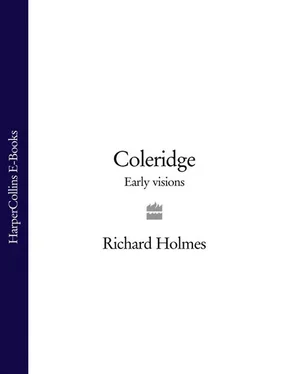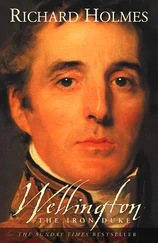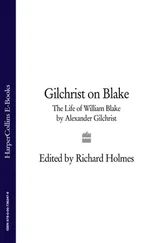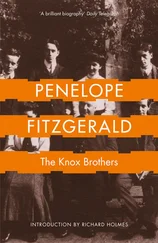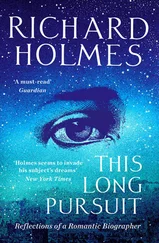Coleridge could instantly recognise this aspect of himself in many of the gentle, highly musical, and nakedly emotional sonnets, with their familiar imagery, such as “The Bells, Ostend”:
…And hark! with lessening cadence now they fall!
And now, along the white and level tide,
They fling their melancholy music wide;
Bidding me many a tender thought recall
Of summer-days, and those delightful years
When from an ancient tower, in life’s fair prime,
The mournful magic of their mingling chime
First waked my wondering childhood into tears!
In discovering Bowles, Coleridge found that for the first time in his life he was reading “a contemporary”; unlike the remote classics, these poems possessed an immediate reality of circumstances for him, so as to “inspire an actual friendship as of a man for a man”. They assumed “the properties of flesh and blood”. 30For the next five years, until he became aware of Wordsworth (who had also been greatly struck by Bowles, stopping to read through the entire volume while crossing London Bridge), they were the dominant influence on his own poetry, though he could only match the “austere” style – “so tender and yet so manly, so natural and real” – intermittently.
In fact throughout this period of apprenticeship there was a long struggle between the “florid diction” and epigrammatic polish and personifications of many of his longer and more formal Odes, Effusions and Monodies; and the Bowles-like plain style, expressing emotion in run-on lines, musical alliteration, and bold monosyllabic statements of personal feeling. This second style – a profound attack on eighteenth-century conventions – became particularly evident in his own shorter pieces and sonnets composed between 1789 and 1794. These included many sonnets about his own experience of change and loss, and family griefs: “To the Autumnal Moon”; “Pain”; “On Quitting School for College”; “On Receiving an Account that his only Sister’s Death was Inevitable”; and his masterpiece in the Bowles’ style (but wonderfully transforming it) “To the River Otter”.
In the Biographia he well described what he was groping after, as a poetry “of the lines running into each other, instead of closing at each couplet, and of natural language, neither bookish, nor vulgar, neither redolent of the lamp, nor of the kennel [ the gutter ], such as ‘I will remember thee’; instead of the same thought tricked up in the rag-fair finery of – ‘Thy image on her wing/Before my Fancy’s eye shall Memory bring.’” 31He counted Bowles’ poetry, along with the friendship of Tom Evans’ family, as the two humanising forces in his academic life as a Grecian. Between them, they drew him out of the bookish maze of metaphysics and classical philosophy, into the living world. 32
In his happier recollections Coleridge described his final period as a Grecian, between 1790 and 1791, as “the era of poetry and love”. With Bob Allen and Val Le Grice he would escort the three Miss Evanses (Anne, Eliza, and Mary) home on a Saturday, from their milliner’s shop in the West End to the family house at Villiers Street, off the Strand. On summer mornings they would carry “the pillage of the Flower Gardens within six miles of Town with Sonnet or Love-rhyme wrapped round the Nosegay”. 33
Even Bowyer’s teaching of poetry became a pleasure and fascination, according to Coleridge. “At the same time that we were studying the Greek Tragic Poets, he made us read Shakespeare and Milton as lessons…I learnt from him, that Poetry, even that of the loftiest and, seemingly, that of the wildest odes, had a logic of its own, as severe as that of science; and more difficult, because more subtle, more complex, and dependent on more, and more fugitive causes.” 34
Both Lamb and Leigh Hunt deny that Bowyer’s teaching of poetry was any more than “commonplace”, and that his taste in moderns reached any higher than Pope. Perhaps Coleridge responded more subtly than they; but in reality he seems to have gained this crucial insight into the structure of poetry from his own reading of Bowles and Edward Young. *
Nevertheless he claimed too that Bowyer was an early champion of the plain style: “he showed no mercy to phrase, metaphor, or image, unsupported by sound sense…Lute, harp, and lyre, muse, muses, and inspirations, Pegasus, Parnassus, and Hyppocrene were all abominations to him.” 35Perhaps this was so; but the fact remains that his main contribution to the Christ’s Hospital “Album” for 1790 was the highly ornate “Monody on the Death of Chatterton”, packed with eighteenth-century personifications, and opening with full bardic diapason: “Now prompts the Muse poetic lays” – the very style that Bowyer was meant to abominate.
The truth seems to be that he was experimenting with every kind of poetic style and pose. His worship of Chatterton was genuine, and he had copied Bowles’ “Monody on the Death of Henry Headley” into his hymn-book to inspire him. But this did not prevent him from turning the solemn enterprise on its head with an answering “Monody on a Tea-Kettle” for George:
While Bats shall shriek and Dogs shall howling run
The tea-kettle is spoilt and Coleridge is undone!
In March 1791 he also sent his brother a Pindaric ode on Euclid’s geometry of ghastly ingenuity. His accompanying comment on learning mathematics – a thing he could never do – contains an interesting prophesy of critical debates to come: “though Reason is feasted, Imagination is starved: whilst Reason is luxuriating in its proper Paradise, Imagination is wearily travelling over a dreary desert.” 36Those images of fruitful Paradise and sterile desert were to haunt him long after.
Officially his career at Christ’s Hospital ended in triumph. As the senior Grecian in his year, he was awarded in January 1791 a School Exhibition worth £40 to take him to Cambridge, renewable for four years; and the following month obtained a place at Jesus College, with a promise of a Rustat Scholarship of £30, especially reserved for the sons of clergymen who showed outstanding merit. Bob Allen went to Oxford without an award, and Val Le Grice did not go up for another year. These awards delighted his family – especially George – and promised to relieve them of most of his expenses, which normally would have been more than £100 per annum.
Yet throughout that last winter Coleridge was periodically ill with rheumatic fever, contracted as a result of a late autumn bathing expedition to the New River. For several months he spent long periods in the school sanatorium, dosed with opium to help him sleep, and doing little except write some striking scraps of poetry. He lay listening to the distant shouts and laughter of the boys in the cloisters, as he recorded in his sonnet “Pain”. Coleridge’s long history of illness – often recurring in damp climates, and during winter months – now began. The sonnet is his first vision of the feverish invalid, besieged by “the trembling sense of wan Disease”, cut off from the normal, healthy daylight world around him, a theme to be powerfully developed. 37
He also wrote a love-poem, “Genevieve”, addressed to his young nurse, whose short lyrical lines contain the first hint of the ballads he would later write. They praise her tender solicitude and generous, maternal bosom in its starched apron like a swan:
When sinking low the sufferer wan
Beholds no hand outstretch’d to save,
Fair, as the bosom of the Swan
That rises graceful o’er the wave,
I’ve seen your breast with pity heave,
And therefore love I you, sweet Genevieve! 38
The close association of poetry with sickness, feverish dreams, and isolation, set against the consoling, healing presence of the beloved, was now initiated. The theme was deepened by tragic sickness in his own family. Early in 1791 came news of Luke’s sudden death of a fever at Exeter; and this was quickly followed by the death of his beloved Nancy, after a long consumptive illness. Again, Coleridge turned to poetry, writing several more sonnets of deep and clumsy emotion:
Читать дальше
